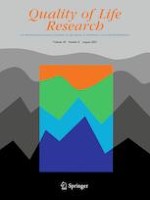28-03-2021
Health-related physical indicators and self-rated quality of life in older adults with neurocognitive disorder
Gepubliceerd in: Quality of Life Research | Uitgave 8/2021
Log in om toegang te krijgenAbstract
Purpose
This study aimed to identify the association between health-related physical indicators—sarcopenia-related factors, physical fitness, independence in activities of daily living (ADL) and habitual physical activity—and self-rated quality of life (QoL) in people with neurocognitive disorder (NCD).
Methods
This cross-sectional study included 115 participants (78.22 ± 7.48 years; 74.8% female) clinically diagnosed with NCD. Self-rated QoL was evaluated using The Quality of Life-Alzheimer’s Disease (QoL-AD). Dual energy X-ray Absorptiometry, handgrip strength, Short Physical Performance Battery, and the 6-m Walk test were used to assess sarcopenia-related factors. Senior Fitness Test and One Leg Balance test, Barthel Index, Baecke Modified Habitual Physical Activity Questionnaire were used to determine physical fitness, independence in ADL and physical activity, respectively. Regressions analyses were performed to examine associations between these variables and QoL-AD.
Results
Data from univariable linear regression analysis revealed that self-rated QoL was associated with sarcopenia-related factors (lower body function, handgrip strength, gait speed, and appendicular skeletal muscle mass index—ASMI), physical fitness (upper-and-lower-body strength, agility/dynamic balance, cardiorespiratory fitness and body mass index), habitual physical activity and independence in ADL. Results from multivariable regression analysis showed that ASMI (B = 1.846, 95% CI 0.165–3.527, p = 0.032) and lower body function (B = 0.756, 95% CI 0.269–1.242, p = 0.003) were positively associated with self-rated QoL. These variables explained 20.1% of the variability seen in self-rated QoL, controlling for age, sex, marital status and education.
Conclusion
Sarcopenia-related factors, namely lower body function and ASMI, should be acknowledged in future research studies as critical health-related indicators associated with QoL in people with NCD.
Trial registration
ClinicalTrials.gov—identifier number NCT04095962.
